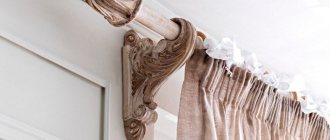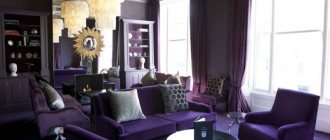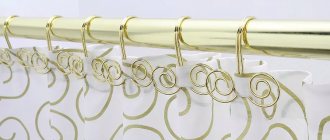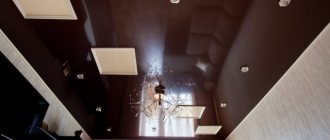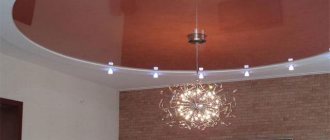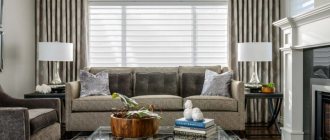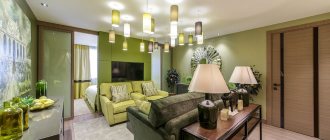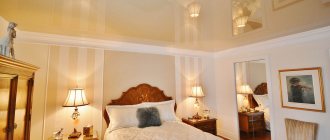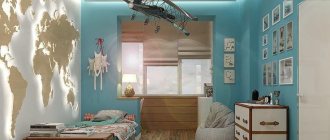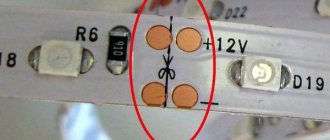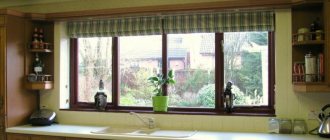The modern variety of design options for curtain rods and types of curtains for them allows you to choose the best, most suitable one. A solution such as ceiling curtain rods for suspended ceilings has an aesthetic appearance, allowing you to partially or completely hide unwanted details. They are easy to hang almost any curtains, including heavy two- or three-layer ones, as well as roller ones made of various materials.
It is important to select a suitable cornice even before you install the tension structure.
Stretch ceilings, cornices: how compatible are these interior design elements?
In various options, curtains come directly from the ceiling or are fixed high on the wall, but the combination of hanging, tensioning systems with a cornice has some technical limitations.
Ceiling cornice is a bright individualization of the ceiling area and the room as a whole.
The high popularity of the ceiling structure is due to the following factors:
- This design for the top of the room is relatively simple, you can do it yourself;
- the design comes out beautiful and does not lose its appearance for a long time;
- the tension object is reliable, as it protects against excess noise and possible flooding from neighbors above;
- The variety of textures and colors allows you to match it to almost any interior style.
It provides a visual expansion of space.
Advice. The first thing you should decide on is the installation location, the type of curtain rod itself, and the appropriate type of curtains.
Types of cornices used for suspended ceilings
Expert opinion
Smirnova Ekaterina Anatolevna
7 years of experience in interior design, professional architect
Most owners of apartments or other real estate consider curtain rods to be interior elements necessary for hanging curtains. But in reality they have great functionality.
As for the technical side, after choosing a cornice under the curtains it will not be difficult to attach it. You need to know which curtain rods are best to hang on suspended ceilings so that everything is beautiful and functional.
Typically, such a strip is a pipe or profile along which fasteners of various types can be moved in both directions. In turn, curtains, tulle and curtains are attached to them. As a result, there is a beautiful curtain in the window opening, which solves the decorative and masking problem.
The design of the slats for curtains depends on what function they are to perform. If the design of curtains with a suspended ceiling involves the creation of a decorative option, then the light-weight fabric will not put a strong load on the hanging structure.
When curtains need to perform light-protective or fire-prevention roles, then the curtain rods must have increased strength, especially with regard to the attachment points. Ceiling cornices for tension systems are distinguished by their structural design, and the appearance, shape and method of installation of the product are of particular importance.
When making their choice, the following criteria are taken into account:
- affordability;
- feature of the product shape and structural device;
- ease of operation;
- ease of installation.
Installation and further operation of the cornice should not cause problems.
Ceiling design, which involves installing a stretch ceiling under the ceiling, allows you to install the following types of cornices:
Types of cornices used simultaneously with tension systems
Curtain rods for tensioning structures can be ceiling, wall, or hidden. They look and are mounted in different ways. As a constructive type of home decor, a simple cornice serves for hanging curtains, representing a profile or a thin pipe along which fasteners in the form of rings, hooks, etc., move with a slight movement from side to side.
Wall-mounted models are mounted on two brackets.
The curtain, suspended on fastenings, performs an aesthetic, light-protective, masking, and, less often, zoning, fire-fighting function. For thin decorative curtains, a lightweight hanging structure is purchased; for multi-layer, dense, heavy ones, it is securely fastened, as it experiences increased load.
Steel curtain rods are great for heavy curtains.
Wall hangings are the most common in all types of interiors. They can be profiled - one, two or three rows or in the form of a rod, two to four meters long. The product can be installed anywhere on the wall – even almost in close proximity to the “sky” of the room.
There are combined models.
The ceiling element, always mounted together with a suspended ceiling, looks different. When choosing, take into account:
- appearance of the product;
- its cost;
- correct choice of shape and design;
- installation complexity;
- ease of use.
This will visually raise the ceiling.
Installing a cornice directly on the ceiling visually increases the height of the room, but installation on a tensioned surface will require additional reinforcement of the latter.
If you want the curtains to flow straight from the ceiling, then you need to make a niche in front of the wall.
A hidden cornice is the most beautiful, stylish option, in which the curtains and ceiling form a single ensemble. It is quite difficult to install a product correctly and accurately - if you do not have experience, it is better to entrust this work to a specialist, then the excellent result will compensate for all the costs.
Single-tier models place all curtain panels on the same level.
Expert advice on choosing and installing cornices
The following recommendations will help you avoid mistakes when choosing the appropriate curtain rod option and its installation:
- buy a baguette with a small margin;
- take into account the weight of textiles. For bulky curtains, a plastic baguette or string version will not work; they will bend under the weight of the material;
- mount the curtain in such a way that the textiles hanging on it do not come into contact with the heating radiator, and the window opens and closes freely;
- If you have blinds installed on your windows, it is better to refuse curtains. Heavy cluttering of the window opening with decorative elements will spoil the interior;
- When choosing a cornice, be guided by the design of the room. Do not use complex designs in a minimalist interior; carefully select the baguette material to match the overall style. Wooden curtains in a high-tech direction will look inappropriate, but for a classic style or rustic design, this option is the most suitable. Stretch ceilings and cornices should also be combined with each other and harmoniously complement each other;
- When purchasing a product, check that the kit is equipped with the necessary parts (plugs, hooks, special fasteners, decorative overlays and other elements);
- By placing lighting, emphasize the advantages and hide the imperfections of the finish.
It is not difficult to learn the technique of installing a cornice to a suspended ceiling, just as it is not difficult to mount a baguette to a suspended covering. It is important to choose the right fastening systems for curtains and installation method, because the slightest mistake can damage fabric or film panels.
Attaching cornices to suspended ceilings: how to do it step by step
Since the ceiling and wall hanging elements are two different structures, they will be attached differently. The fixture for the walls can be hung at any time, while the installation location for the ceiling is planned in advance - it will be impossible to move it.
A visual effect of a textile waterfall is created.
How to attach a ceiling cornice
The stretched material itself is soft, thin, elastic. To prevent the product from deforming under the weight of the curtains and cornice, I reinforce it with wooden blocks mounted between the base plane and the curtain itself. When using heavy, multi-row curtains, several curtains should be taken - this is necessary to strengthen the entire structure.
The main difficulty here is that the place where the cornice will be suspended is determined by the master in advance - even before the ceiling is stretched.
What else is important to consider:
- Before installing the rough ceiling, you need to mark it and make a sketch;
- the block is chosen a little thinner than the distance from the concrete to the film - the embedded parts should not rest against the stretched fabric;
- the wood of the bars is pre-treated with special compounds that prevent rotting and mold;
- to install the cornice on the ceiling surface, you need reinforced rings - they are fixed where the suspension connects to the mortgage. A place for fastenings is cut out inside the ring;
- When hanging the product, folds, wrinkles, and unevenness should not form on the stretch fabric.
Models are available in plastic or aluminum. Their distinctive feature is the presence of a decorative strip covering the hooks.
How to attach a wall cornice
A wall-mounted curtain rod allows you to hang curtains almost to the very top, but not closely - for free moving structural elements (rings, eyelets) you must leave a distance of at least 1.5-6.5 cm, otherwise these parts will quickly scratch or rub through the film or fabric ceiling.
It is also important to choose curtains that match the color of the top of the room, the hanging itself.
Advantages of open cornices
This cornice is attached directly to the ceiling and is visible. The advantage here is that you can choose a beautiful configuration and color, which will be a small addition to the design.
Also, the advantage of such a fastening is that it is clearly visible and in the event of a breakdown, the cause can be easily identified. Well, dismantling is simple and completely possible with your own hands, without the involvement of outside craftsmen.
Hidden cornice in a suspended ceiling: pros, cons of designs
A curtain of a standard type on a suspended ceiling photo, sometimes suspended from a completely hidden cornice. Its main advantage is its beautiful appearance, which fits perfectly into the vast majority of interior styles, the disadvantage is complex installation that requires increased accuracy.
Most often used to decorate rooms in a classic or Provence style.
What you need to know to properly secure such a suspension:
- the product is installed simultaneously with the tension structure;
- before starting work, measurements are taken and markings are made on the rough ceiling;
- the profiles on which the canvas is stretched are attached to the walls where there is no suspension;
- in place of the future cornice, a niche is formed - a space hidden behind the beams, profiles, where it will be installed;
- the width of the resulting niche should be no more than 8-10 cm. - these parameters will make it almost invisible from any angle, and the curtains will literally “flow” from the ceiling;
The hidden product is often illuminated with LEDs, which allows you to create a “magical” interior.
Tip: a hidden cornice can become an original zoning element in studio apartments, where it is necessary to temporarily separate the sleeping and kitchen areas from all others.
What material to choose for the cornice
Whatever cornice we are talking about, they are made from two popular materials:
- Metal
- Plastic
The first one is more durable and stronger, but such curtain rods often have sharp corners, on which the curtain fabric clings and breaks. Also, if the metal rusts, this can affect the material of the curtains.
Plastic is a good material, but it is fragile. If you close the curtains carelessly, the rails and hooks may crack.
It is best if you find a combined option: a metal frame and a plastic film on top. But, this is all theory. It's time to start practicing and figure out how you can fix the cornice on a stretch ceiling with your own hands.
Types of curtains for curtains under suspended ceilings, description
The best, correctly selected ceiling curtains for suspended ceilings, photos, look very solid and luxurious - they start at the top, reaching the floor surface. Curtains for different types of curtains differ in materials - metal structures are suitable for heavy ones, plastic ones are suitable for light ones, wooden ones are suitable for ethnic, ecological, classic interiors.
The curved trajectory must be calculated in advance and attached to the ceiling directly to the embedded elements.
Advice. When installing curtains, be sure to take into account that the convenient distance from it to the window is approximately 23-33 cm. If hung closer, difficulties will arise with opening and closing the curtains.
How to hang a curtain on a suspended ceiling: open option
With the open installation method, markings are made first. Then, using dowels, a mounting block is mounted, a film or fabric is stretched, rings are inserted into the holes - the curtains are hung directly on them.
Flowing curtains have a special aesthetic magic.
Niche for the curtain: subtleties of hidden execution
A hidden hanging option is considered after purchasing the curtain; the size of the niche depends on its parameters. The product is mounted on the base ceiling, which does not reach it by a few millimeters, after the profile for hanging the canvas itself has been fixed.
Such curtains can create a small design revolution even in the drab interior.
Which curtains are better for a suspended ceiling?
It is impossible to give a definite answer as to which curtain rods are best. In this case, the choice depends on personal preferences. Before you start making your choice, you should pay attention to the material that the manufacturer uses in the manufacturing process of the finished product:
- aluminum - such designs are the lightest and have a high level of reliability, however, it is worth considering that such models are suitable only for light curtains;
- plastic is the most popular option today, such products have an affordable price, a wide range of products, plastic curtains are easy to install, in addition, they are able to withstand more weight than the previous model;
- steel is the most durable material, products made from it have a high level of reliability, a long service life, such options are excellent for fairly heavy and multi-layered fabrics;
- wood - considered one of the most expensive natural materials used for making cornices; these models are perfect for rooms with high walls.
In addition, it is worth taking into account the fact that curtains can be installed in several ways, which is quite convenient. Thus, if the wall on which there is a window opening is made in an irregular shape, then you can use a niche, as a result of which you can repeat the outline of the wall without any problems.
Examples, photos in the interior
Original curtains for curtains under a suspended ceiling in most photos on the Internet are selected to suit different styles:
- classic - a baguette-type item decorated with sliding curtains;
You should first of all start from what you ultimately want to see in your apartment or house.
- Japanese - the design consists of several panels decorated with straight canvases that are easy to move;
Any cornice design finds its buyer.
- high-tech - the product is completely hidden, decorated with a silver curtain and LED lighting;
You will be able to see the curtains at full length, maintaining the illusion of increasing the height of the room.
- baroque - a rough wooden cornice, decorated with carved peaks at the ends, located a few centimeters from the ceiling, decorated with tapestry curtains;
For rooms with a classic type of interior, such options are a real find.
- modern - a narrow ceiling object, controlled using a mobile remote control;
By programming the controller, it is easy to ensure that the curtains open at a certain time in the morning, close halfway at lunch, and close tightly in the evening.
- minimalism - a straight rod to match the color of the top of the room, the only one-color curtain moved on grommets.
The price for them varies depending on the type of design, complexity and number of elements used.
Ceiling cornices look great in bay windows, where it is impossible to build a regular, direct suspension; they are used to decorate “complex” dormer windows, arches, and, if necessary, neatly highlight separate zones in a large open space.
Curtain rods for suspended ceilings: two options
The most common type of cornice for suspended ceilings is the wall cornice.
The wall cornice is so “many-faced” that its design features and appearance suit a great many consumers.
This cornice has quite a lot of advantages.
So, its advantages:
- Installation work is not only not particularly difficult, most homeowners who have ever held a drill or hammer drill can do it;
- A huge selection of models - very different textures and modifications;
- Low price.
You can learn more about the types, design and subtleties of choosing wall-mounted curtain rods from the material: https://homeli.ru/dekor/shtory/nastennye-karnizy-dlya-shtor
However, ceiling cornices are still the most interesting for many.
Advantages of ceiling cornices:
- The ceiling area, thanks to such cornices, looks much more original;
- There is a real opportunity to hide the curtain fasteners;
- Optically, the space of the room increases significantly.
In addition, if the ceiling in the room is high enough, then it is possible to install an electric drive, which will allow you to move and open the curtains using a remote point, which provides additional comfort and convenience.
A modern string cornice can be easily mounted to both the wall and the ceiling. Find out how to do this yourself on the website: https://homeli.ru/dekor/shtory/strunnyj-karniz
Installation of ceiling curtain rod: 3D panorama (video)
And in conclusion, I would like to say the following. A hidden cornice in a suspended ceiling is not such a complex design, which involves some special knowledge and skill. It's all about the hidden niche! You can do it yourself. This is done once and for a very long time. As for the effect produced by such simple installation work, it will delight you for many years, and surprise your guests with the originality of this solution and the unique elegance of placing your curtains! Be careful when working with the tension fabric. Good luck in arranging your apartment!
Which cornice to choose for a stretch ceiling: depends largely on the price
The modern construction market offers a huge number of different products.
As for cornices, with a real abundance of goods, the choice can be difficult.
One of the most significant factors is the price of the product, especially if you take into account the often meager budget that the landlord allocates for the renovation of his own home.
What determines the price of cornices for suspended ceilings:
- A wall-mounted cornice is perhaps the most budget-friendly option. Of course, its price directly depends on the material from which the cornice is made. In addition, it is not at all necessary to invite specialists to install it - most consumers are able to do it themselves, with their own hands.
- As for ceiling cornices, the price here is also significantly different. The fact that the price of such cornices varies depends on their length, as well as whether corner elements will be used, or double or triple cornices.
- The price for baguette cornices is noticeably higher.
In addition to all of the above, you should also take into account the costs of installing them if you hire specialists for this.
Materials
To understand which cornice is best to use for a suspended ceiling, you should understand the properties of all the materials from which it is made. For the production of most models, plastic is used, since it is characterized by minimal weight, a wide range of colors and resistance to negative influences such as corrosion or rotting.
However, natural raw materials continue to be in demand, so modern models can be created from the following materials:
- Steel.
- Aluminum.
- Polystyrene.
- Polyurethane.
- Wood.
Plastic
Plastic products are very popular due to their low cost and good strength properties. If necessary, the structure can be further strengthened. Plastic is also not subject to corrosion or rotting.
Aluminum
Complex openwork shapes and decorative elements are made on the basis of aluminum. The advantages of this material include:
- Ease of processing.
- Affordable price.
- Invulnerability to moisture.
- Wide range of models.
- Possibility of implementing any geometric shapes and non-standard options.
Often, bay windows are finished with aluminum structures and complex curtains are installed.
Steel
When wondering what types of cornices there are, you should also pay attention to steel structures. In most cases, they have the shape of rods, but square products are also available for sale. Depending on the interior features, steel can be finished with colored materials, including:
- Gold.
- Bronze.
- Brass.
- Copper.
The aesthetic appeal of structures is also enhanced by chrome plating. The main advantage of steel cornices is their high strength. However, they are heavy, so for error-free installation it is necessary to provide a stable mounting base.
Tree
Wood products are considered “classics of the genre”, which never loses popularity. To decorate wooden models, they are tinted, varnished or painted, and also processed using wood carving.
The disadvantages of wood include high cost and vulnerability to influences such as moisture or fire.
A wooden cornice is also quite heavy, and its installation process requires professional help. In order for a product to serve for a long time without deformation or damage, it needs to be provided with optimal climatic conditions.
Choosing ceiling cornices for suspended ceilings: consumer reviews
Which curtain rods the consumer still prefers can be approximately calculated in percentage terms based on sales or consumer reviews.
Of course, such results cannot be accurate, much less taken as a basis.
Not everyone leaves reviews, and sales figures are a closely guarded secret. Let’s try to understand this subject based on reviews, since there are a lot of them on the Internet.
Some useful tips from professionals on how to attach a cornice yourself:
So, reviews:
- There were three options: wall cornices, hidden ceiling cornices and open ones. We still can't decide. With a ceiling, won't the cornice fall on your head?
- And we like the old cornices, the ones on the wall. It looks really cool!
- We decided to make a ceiling one, right from under the ceiling.
- And ours are wall-mounted. The ceilings in the rooms are high, a lot of money was spent on curtains. And then you would have to hire people, but they don’t charge a lot of money.
- We can’t see the cornice; the curtains “grow” straight from the ceiling. We don't regret this option!
- I prefer the cornice from under the ceiling, hidden when the curtains seem to flow from above. That's what we plan to do, at least.
- We prefer the hidden cornice.
- What's the difference, exactly? The main thing is that the ceiling is beautiful, and we prefer classic, round wooden ones with rings.
- I like it when the curtains seem to come out of the ceiling. Very beautiful and great!
- The ceiling height in the house is 2.7 m. Because of this, they hung wall ones.
- We prefer hidden cornices - they look more profitable and aesthetically pleasing. But this is a matter of taste.
- I thought and wondered how you can attach a ceiling cornice to the film?! She's flimsy. No, they did it very firmly. Screwed the cornice to a block of wood!
- And to me it’s as purple as the cornice will be. If only the ceiling is glossy and you can see yourself in it in the bedroom, if that’s the case.
- The ceiling hidden cornice in the niche is reminiscent of the design of dark curtains in small cinemas, already in the nineties, which were noisily drawn by an electric motor.
- The cornice is not the main thing. The main thing is the ceiling and lighting.
- We made it hidden, very beautiful. The controls are remote control, so it’s convenient and beautiful. I did it once, and for a long time! True, it was a bit expensive, but we really like it.
- Our hidden curtains with cornice cost us a pretty penny. True, it turned out very well, but it was also expensive.
- The cornice is just a ceiling one – a nice thing! Beautiful, reliable and simple. Nothing particularly sticks out anywhere, no sticks.
- If you are going to make a suspended ceiling, then do it like a human being! Besides, these are not such costs. I thought they were mortgages, some complex and expensive ones, but no, it turned out to be just a piece of wood. And this is done quickly by an experienced master. So.
As can be seen from the above reviews, it is absolutely impossible to say that there are as many opinions as there are people. Preference, as can be seen from the above reviews, is still greater for hidden cornices than for others.
Some tips
To choose the best option, it is first recommended to select curtains that will serve as a frame. If you plan to use organza or tulle, you can choose any design since it is a lightweight fabric. A material of high density, such as tapestry or velvet, requires the choice of plastic or steel structures. Fasteners must also be durable and it is not recommended to save money on purchasing them, so as not to have to deal with expensive alterations in the future.
For lovers of the classics, it is worth remembering a few rules: the length of the cornice is 20 cm longer than the window on each side. If there are several windows, then a smaller width, for example, 15 cm, is sufficient.
Another important aspect is the distance between the cornice and the walls with the window opening. The fastening must be done in such a way that the curtain does not touch the window sill or radiator. In addition, the aesthetic appearance is disrupted and causes a lot of inconvenience. When opening, the curtains should completely clear the opening.
A few more recommendations for installing fasteners. Before starting work, you need to make markings. If the curtain is longer than the specified length, it must be cut. The ends of the structure are closed with a special plug. Fastening is carried out in parallel order. It is better to make the connection from the middle. Holes for self-tapping screws should be made using a drill. The average distance is 50-60cm. If the material is heavy, the distance can be reduced.
Sometimes it is advisable to choose them with a rounded shape. Then it is recommended to use an additional set with restrictive rings for limited movement along the cornice. In this case, the folds look neat.
A few examples of cornices for suspended ceilings:
